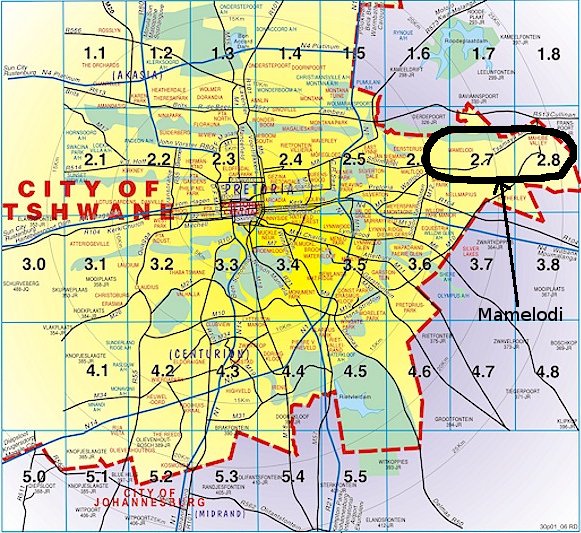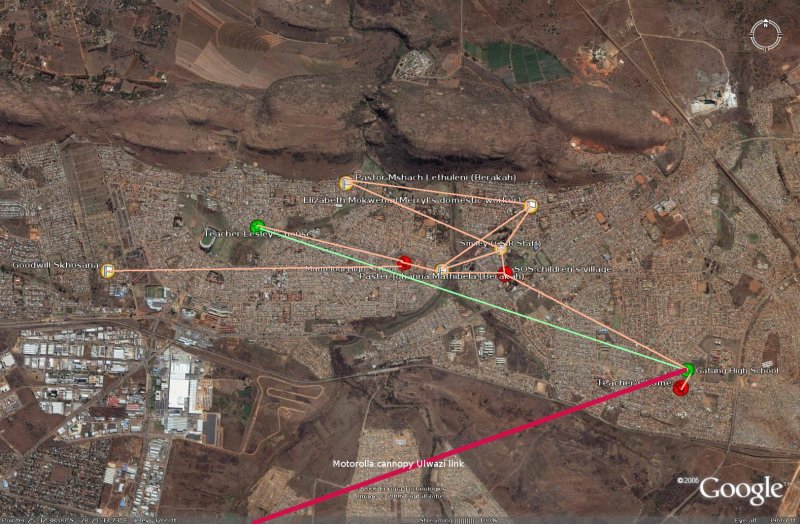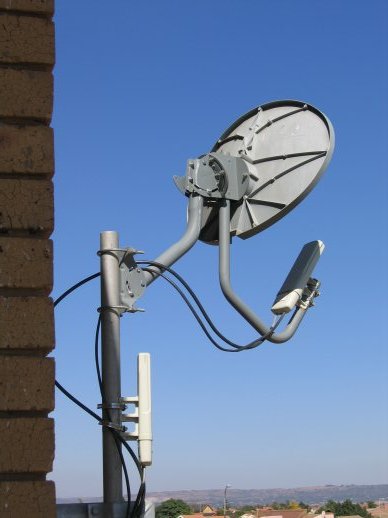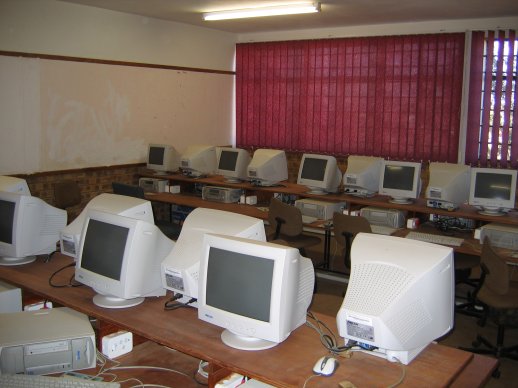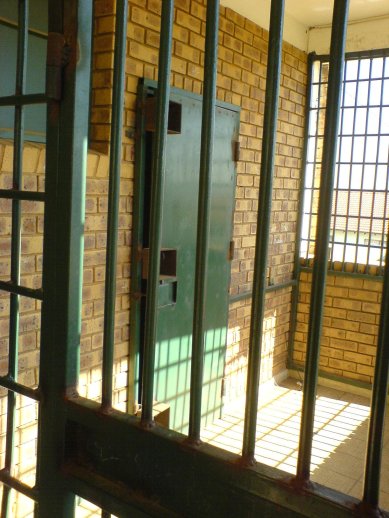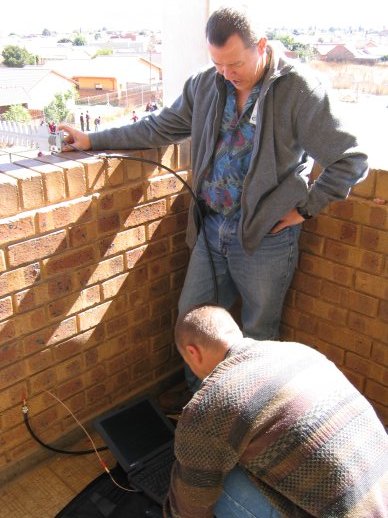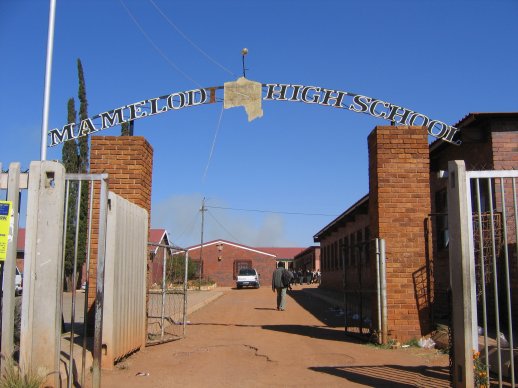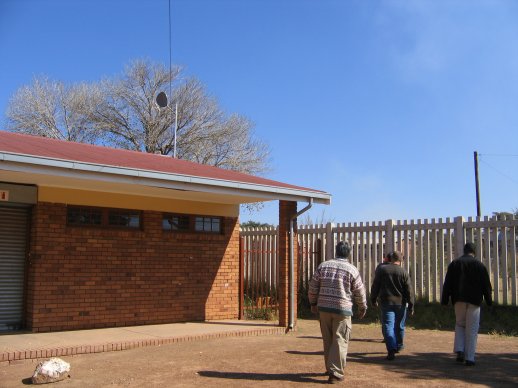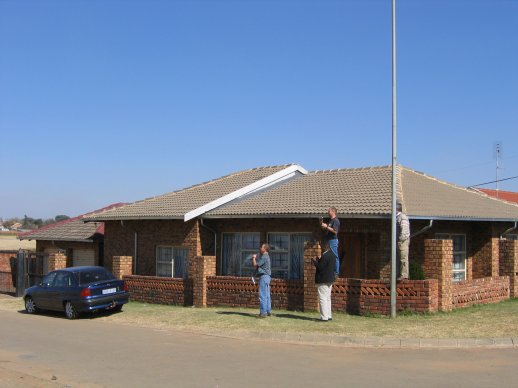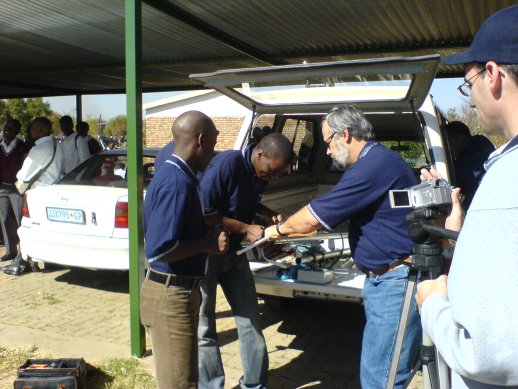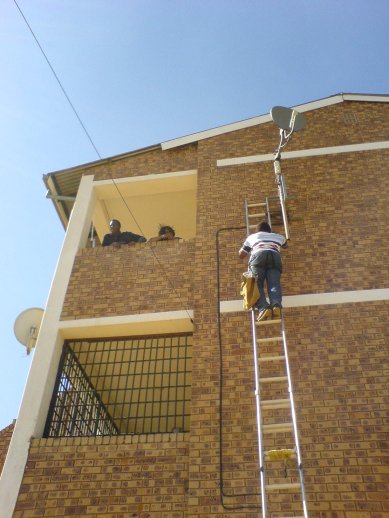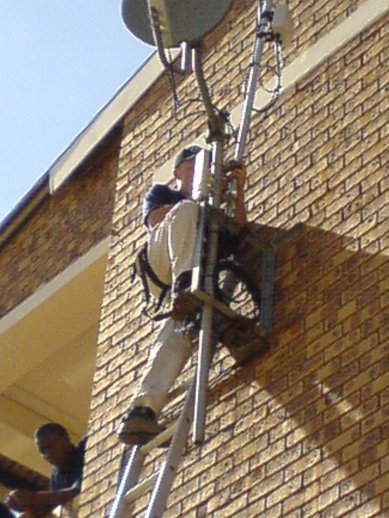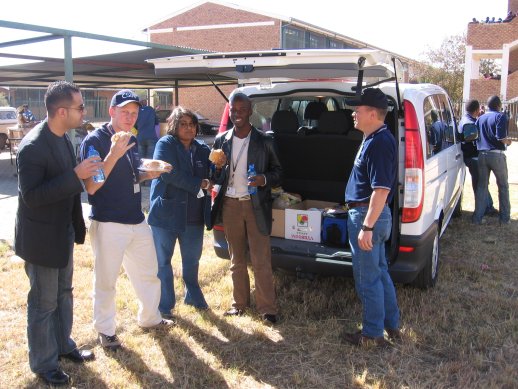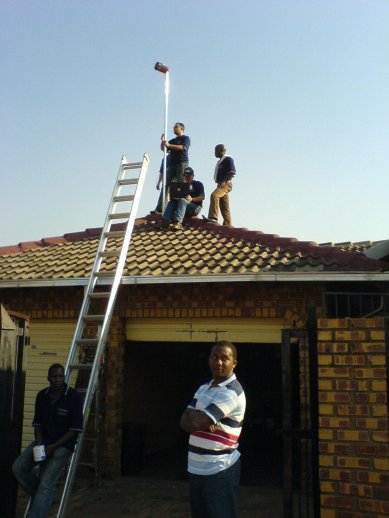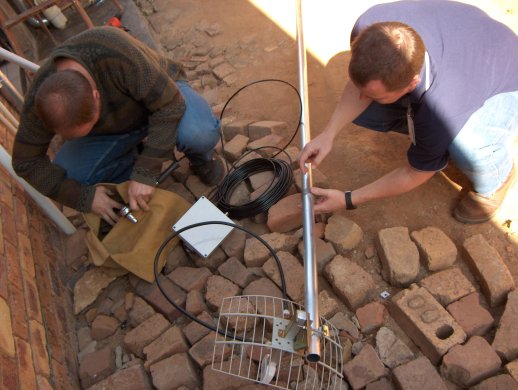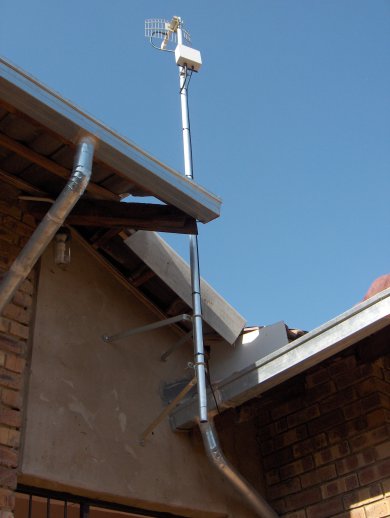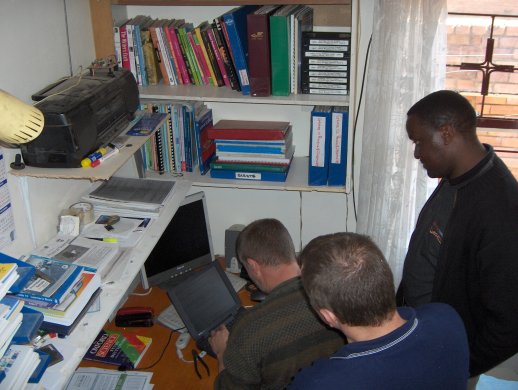Mamelodi Mesh: Difference between revisions
| Line 81: | Line 81: | ||
== 26 May 2006 – | == 26 May 2006 – Site surveys == | ||
This trip was used to survey some the potential installation sites and understand what sort of structures were in place for mounting equipment and to check for line of sight issues etc. | This trip by John, Johann and Karel was used to survey some the potential installation sites and understand what sort of structures were in place for mounting equipment and to check for line of sight issues etc. | ||
[[Image:Mamelodipcanopy-system.jpg]] | [[Image:Mamelodipcanopy-system.jpg]] | ||
Revision as of 23:24, 17 August 2006
Location
Mamelodi is situated about 20 km east of the centre of the City of Tshwane (Pretoria). It is bordered by the Magaliesburg ridge in the north, Pretoria's northern suburbs such as Silverton (industrial area) and "the Willows" (residential area) in the south, another township called Eersterus in the west and another large Magaliesburg ridge running north-south in the east. The total area is approximately 25 square kilometres and the unofficial population of Mamelodi is now close to one million. It is a fairly flat area other than the northern and eastern ridges that form the boundary around the township.
History
Mamelodi was established in 1953, and started with a mere 16 houses built for black people which were removed from other areas according to the Group Areas Act. The first residents worked at bottle-making and brick factories. The name "Mamelodi", which means "mother of melodies", derives from the name given to president Paul Kruger (the first president of the Transvaal) by black people because of his unusual ability to whistle and imitate birds.
Living conditions
There is a diverse set of living standards in Mamelodi, ranging from well built brick houses to small informal dwellings made out of sheet metal known as shacks. On the whole the areas in the west mostly consist of brick houses and low cost RDP (Reconstruction and Development) houses made out of large cement bricks. There is an increasing number of informal shack dwellings in the east of Mamelodi.
Existing work in the area with schools
The Mamelodi Broadband E-Learning Pilot Project aims to explore educational opportunities between five schools in the Pretoria area using a Motorola Canopy Radio Network. The initial phase of the project has been made possible by a small grant from the Department of Communications
It's widely recognised that this country lags behind in effective Maths, Science and Technology teaching. Too few teachers and too few resources compound the problem. The result is learners leaving school without the ICT skills essential in today's marketplace.
Given the strength of South Africa's ICT sector and the potential of many of its learners, it's an irony that needs attention.
St Alban's College in Pretoria is one of the schools in this country that is determined to share its resources, assist with Science education and change the lives of those learning in under-resourced schools. Led by Ron Beyers, the Ulwazi E-learning Project harnesses ICT and brings it directly to those who need it.
The Mamelodi Broadband E-Learning Pilot Project, sponsored by the Department of Communications, has just completed its first three months. Key partners include Motorola and OMEGA Digital Technologies According to Beyers, 'It's a huge success. The kids are hungry for it and because it's totally interactive and the learners are actively involved, it highlights the difference between theoretical or book learning and real time visual, practical learning.'
The project demonstrates a practical and effective application of technology for learning. It links St Alban's College with Mamelodi schools, Gatang High, Mamelodi College, Mamelodi High and Modiri Technical High. The link is a high-speed, broadband wireless network capable of data rates of several megabites per second, which is maintained by Motorola.
Using Motorola's 5GHz Canopy technology, which, once installed, runs at zero cost, the network allows the teacher to use his computer, microphone, web cam and interactive whiteborads (SMART boards). Whatever he writes on the SMART board appears virtually simultaneously on the linked SMART board in Gatang High. At the same time, the learners in the Mamelodi schools can take control of the computer in St Alban's (15 km away) and interact with the software in real time.
Beyers uses Microsoft Netmeeting software, available on most pcs and the learners in the connected schools are not only connected but totally immersed in the learning process in a virtual classroom.
Given the success of the pilot project, Beyers is now seeking further sponsorship and partners to expand the concept and bring real time interactive ICT learning to more schools.
Work with CuWin
The Champaign-Urbana Community Wireless Network (CUWiN) is a world-renowned coalition of wireless developers with a mission to “connect more people to Internet and broadband services; develop open-source hardware and software for use by wireless projects world-wide; and, build and support community-owned, not-for-profit broadband networks in cities and towns around the globe.” CUWiN is a non-profit 501(c)(3) organization head quartered in the small town of Urbana, Illinois; yet it has received considerable national and international attention during its half-decade of successful open-source development.
The mamelodi mesh network is the first of three networks that will be implemented using CuWin's wireless mesh technology as part of the OSI funded project. Two others in Mpumalanga – Bushbuckridge and Barbeton are also scheduled for completion during 2006. The Mamelodi network which is only 10km from the CSIR is an ideal network to test run the technology as the network is close by and problem solving can be done quickly.
Other work with CuWin includes the following
1.Porting their HSLS protocol to Linksys WRT54G 2.Development of a bandwidth management tool for mesh networks
What problem is being addressed
The main problem being addressed is the issue of affordable broadband connectivity in the area. Most community members in Mamelodi cannot afford the extremely high cost of broadband connectivity for their houses. Currently the most affordable broadband solutions are in the region of R600 per month.
The key driver for this network is going to be the expansion of the already established Ulwazi education network to more people such as teachers and pupils. We would also like to use the Mamelodi mesh to connect CSIR staff living in Mamelodi to the CSIR.
Social challenges
We have already encountered some entrenched power bases at the Gatang school where we did our first installation. By giving the teacher who is in charge of the computer centre a link to his house and not the principle, we were affirming his importance above that of the principle. The principle was furious and wanted all the equipment removed. We managed to diffuse the situation by explaining the purpose of the wireless network but it was an important “red flag” when installing a network like this to involve all the decision makers in the community.
Another key social challenge is going to be to raise up a community member who will take ownership of the network and be able to provide technical support to all the participating members. Ideally this person should also provide training to interested members who want to become part of the mesh network.
Backhaul Connectivity
Currently we are seeing this network as an extension of the existing Ulwazi educational network which is solely for educational purposes such as tele-education using smart boards, or linking pupils with the “Fab-lab” a facility to allow young learners to prototype their own mechanical or electronic inventions. There will be a learning portal with open content such as wikipedia and free books available. We will also look for potential sponsors for their internet connectivity, the issue of free internet connectivity is however a controversial topic which needs further investigation.
Network Topology
The above diagram shows the identified sites with links and potential links between them.
1.A Green placemarker: Installed site 2.A Red placemarker: Future installations as part of the Ulwazi network extension 3.A Yellow flag: Possible installations of people linked to CSIR (either staff or friends of staff) 4.Thick red line: Backhaul link 5.Thin green line: Installed link – tested and working 6.Thin pink line: Potential link based LOS prediction
Progress markers
26 May 2006 – Site surveys
This trip by John, Johann and Karel was used to survey some the potential installation sites and understand what sort of structures were in place for mounting equipment and to check for line of sight issues etc.
Motorola Canopy system installed at Gatatang High School as part of the Ulwazi network
Computer centre at Gatang High School - all terminals are using MS Windows but haven't been activated for a year - lab should be converted to Linux thin client
The sad reality of theft in South Africa make computer labs look like maximum security prison
John and Johann checking for exisiting wifi signals in the area from balcony of Gatang High School
Mamelodi High School - another potential node in the mesh
Motorola Canopy system at Mamelodi High School
Lesley's house - science teacher at Gatang High school - a priority node to install in the mesh
SOS Childrens Village - another potential site to connect children onto the network
Mamelodi SOS childrens village home page
8 June – Installation at Gatang High School and Lesley's house survey
We took most of the staff in the wireless africa program at Meraka with to carry out this installation as part of a training excercise. It was a great day, Soloshni provided snack packs and there was a good team spirit amongst all the students and staff. It took musch longer than we thought because of the height of the installation - the attachment point for the equipment was about 10m high. We prebuilt the system on the ground with short mast, CuWin box, antenna and u-bolts. Dare Sokoya, one of our PhD students on using MIMO in mesh networks, was the first to brave the 10m long ladder and try to attach the CuWin equipment onto the exising mast. After struggling for about 40 minutes and eventually getting the u bolts secure he handed over to David Johnson to finish off the installation. David finished tightenting all the bolts and cable-tied the ethernet along the exisiting RF cable running along the wall for the Canopy system. Grant Cabridge in the meantime drilled through the wall with a drillbit that looked large enough to drill a bore hole. After feeding the ethernet through the computer lab wall. John and Johann finished off connecting the system into the swich and checked that the system was responsive. We finally ended the day by visiting lesley's house and checking the signal strength with a laptop and a Cantenna. the gain on the cantenna proved to be weak for the 6km distance between the school and Lesley's house or the home made cantenna was possibly not well built.
Pre-assembling the CuWin equipment on the ground
Dare braving the 10m ladder
David finishing off the installation
Some of the installation team at Gatang High School eating Saloshni's nice snack packs
Testing the signal at Lesley's house using a cantenna
25 July - Installation at Lesley's house
John, Johann and Karel went out to setup Lesley's link. Everything went well and a good quality link was established with Gatang High School where Lesley is a science teacher and also runs the computer lab.
Pre-assembling the CuWin equipment for Lesley's house
Equipment installed and working
John and Johann checking the connection in Lesley's study
